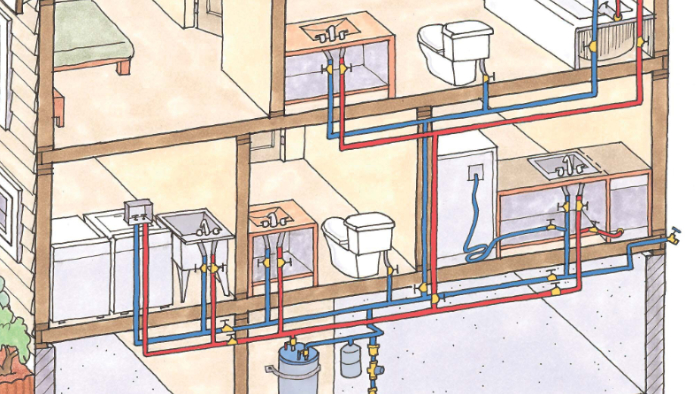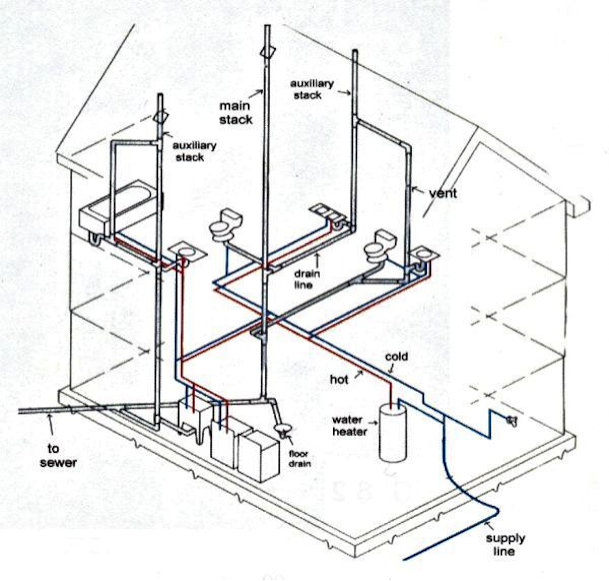What You Need to Know About Your House's Plumbing System Anatomy
What You Need to Know About Your House's Plumbing System Anatomy
Blog Article
What're your insights and beliefs about Exploring Your Homes Plumbing Anatomy?

Understanding exactly how your home's plumbing system works is crucial for every single house owner. From delivering tidy water for alcohol consumption, cooking, and bathing to safely removing wastewater, a properly maintained plumbing system is crucial for your household's wellness and comfort. In this extensive guide, we'll discover the elaborate network that makes up your home's pipes and offer tips on upkeep, upgrades, and dealing with typical concerns.
Intro
Your home's plumbing system is greater than simply a network of pipes; it's a complicated system that ensures you have accessibility to clean water and reliable wastewater elimination. Recognizing its components and exactly how they work together can assist you avoid pricey repair work and make sure every little thing runs smoothly.
Fundamental Components of a Pipes System
Pipes and Tubes
At the heart of your plumbing system are the pipelines and tubes that bring water throughout your home. These can be made of different materials such as copper, PVC, or PEX, each with its benefits in regards to durability and cost-effectiveness.
Fixtures: Sinks, Toilets, Showers, etc.
Components like sinks, commodes, showers, and tubs are where water is made use of in your home. Recognizing how these components connect to the plumbing system aids in diagnosing problems and preparing upgrades.
Valves and Shut-off Points
Shutoffs regulate the flow of water in your pipes system. Shut-off shutoffs are crucial during emergency situations or when you require to make repair work, enabling you to separate parts of the system without interrupting water flow to the whole house.
Water System System
Key Water Line
The main water line links your home to the metropolitan water or a private well. It's where water enters your home and is distributed to different components.
Water Meter and Stress Regulator
The water meter steps your water use, while a stress regulator makes certain that water flows at a risk-free stress throughout your home's pipes system, preventing damage to pipelines and components.
Cold Water vs. Warm water Lines
Recognizing the difference between cold water lines, which supply water directly from the primary, and hot water lines, which bring warmed water from the hot water heater, helps in troubleshooting and planning for upgrades.
Drain System
Drain Pipes Piping and Traps
Drain pipes carry wastewater far from sinks, showers, and toilets to the sewer or sewage-disposal tank. Catches stop sewage system gases from entering your home and likewise catch particles that can create clogs.
Ventilation Pipes
Ventilation pipes enable air into the drainage system, avoiding suction that could slow down drain and trigger catches to empty. Proper ventilation is important for preserving the stability of your plumbing system.
Significance of Appropriate Water Drainage
Ensuring proper drainage prevents backups and water damages. Routinely cleansing drains pipes and maintaining traps can prevent costly repairs and expand the life of your pipes system.
Water Heating Unit
Types of Hot Water Heater
Hot water heater can be tankless or typical tank-style. Tankless heating systems warmth water as needed, while storage tanks keep heated water for immediate use.
How Water Heaters Connect to the Pipes System
Recognizing exactly how water heaters attach to both the cold water supply and warm water distribution lines helps in diagnosing concerns like not enough warm water or leaks.
Maintenance Tips for Water Heaters
Consistently purging your water heater to get rid of debris, inspecting the temperature setups, and checking for leakages can prolong its life expectancy and improve power effectiveness.
Typical Plumbing Concerns
Leaks and Their Causes
Leakages can happen due to maturing pipelines, loose installations, or high water stress. Resolving leakages quickly prevents water damages and mold development.
Clogs and Clogs
Blockages in drains and commodes are often brought on by flushing non-flushable things or an accumulation of grease and hair. Making use of drain screens and bearing in mind what decreases your drains pipes can stop clogs.
Indicators of Plumbing Troubles to Expect
Low water stress, sluggish drains, foul odors, or uncommonly high water bills are indications of potential pipes troubles that should be resolved quickly.
Pipes Maintenance Tips
Normal Inspections and Checks
Set up yearly plumbing assessments to catch problems early. Seek indications of leakages, corrosion, or mineral build-up in taps and showerheads.
DIY Upkeep Tasks
Straightforward tasks like cleansing faucet aerators, looking for commode leakages using color tablet computers, or protecting revealed pipes in chilly environments can avoid major pipes concerns.
When to Call a Professional Plumbing Professional
Know when a plumbing problem calls for professional proficiency. Attempting complex repair services without proper understanding can cause even more damages and higher repair expenses.
Updating Your Plumbing System
Reasons for Updating
Upgrading to water-efficient components or changing old pipelines can enhance water top quality, lower water bills, and enhance the value of your home.
Modern Plumbing Technologies and Their Advantages
Discover technologies like wise leakage detectors, water-saving commodes, and energy-efficient hot water heater that can save money and decrease ecological influence.
Price Considerations and ROI
Determine the in advance expenses versus lasting cost savings when taking into consideration plumbing upgrades. Lots of upgrades spend for themselves via reduced utility bills and less repairs.
Ecological Effect and Preservation
Water-Saving Components and Home Appliances
Setting up low-flow taps, showerheads, and bathrooms can dramatically minimize water use without compromising efficiency.
Tips for Decreasing Water Usage
Simple behaviors like dealing with leakages without delay, taking much shorter showers, and running complete lots of laundry and dishes can conserve water and lower your utility bills.
Eco-Friendly Plumbing Options
Consider sustainable plumbing materials like bamboo for flooring, which is durable and environment-friendly, or recycled glass for kitchen counters.
Emergency situation Preparedness
Steps to Take Throughout a Pipes Emergency situation
Know where your shut-off shutoffs lie and just how to switch off the supply of water in case of a burst pipe or significant leakage.
Value of Having Emergency Situation Contacts Convenient
Maintain get in touch with information for neighborhood plumbing technicians or emergency situation solutions conveniently offered for quick response throughout a plumbing situation.
Do It Yourself Emergency Fixes (When Applicable).
Momentary repairs like using duct tape to spot a dripping pipe or positioning a pail under a leaking faucet can lessen damage until a specialist plumbing arrives.
Verdict.
Comprehending the anatomy of your home's pipes system equips you to maintain it properly, saving time and money on fixings. By complying with regular maintenance routines and staying educated regarding modern pipes technologies, you can guarantee your plumbing system runs efficiently for several years to come.
HOW YOUR PLUMBING SYSTEM WORKS
Which Pipes Do What?
Blue lines = fresh water supply entering the building
Red lines = hot water supply entering the building
Grey lines = pipes carrying waste away from the building and venting pipes carrying gases away from the building (through the roof)
YOUR MAIN PLUMBING SYSTEMS
There are two main plumbing systems that support your home s basic plumbing needs one that brings clean water into your home, and one that sends dirty water away from your home. Connected to the toilet, bath, shower, and other faucets in your home, these two systems keep your water flowing in the right directions.
ACCESSING FRESH WATER
Fresh and clean water is brought into your home through the main water supply line . Filtered through one pipe, this water is pressured to flow into the various fixtures in your home at any given time.
This water can be sourced from a well located on your property, a pond or river (mostly cottages), or, as in most cases, from the city s municipal water treatment centre. However, it is important to note that water that is untreated, such as the water siphoned from ponds or rivers, may not be safe to drink. Personal water supplies always need to be treated for hardness and contaminants before consumed.
MUNICIPAL WATER SUPPLIES
Improve taste and odour
Remove sediment
Eliminate hardness
Reduce chlorine
COLD WATER SUPPLY VS. HOT WATER SUPPLY
Cold water flows into your home or building through the service line, which then distributes hot or cold water to your fixtures. This line is most commonly run through a central column that runs floor to floor. Hot water runs in short and straight pipes as the longer the pipeline, the more heat that will be lost in the transfer. Having shorter pipes also allows residents to access hot water more quickly.
WASTE WATER SYSTEM
Your wastewater system is divided into two parts pipes that send wastewater away from your home and venting pipes that send sewer gas away from your home. Sewage water travels through pipes that flush the water and waste towards local sewers that are operated and managed by your city or town. Most sewer systems rely on gravity to move the wastewater to where it needs to go.
The further away from your toilet or sink, the larger wastewater pipes become. This allows for waste to be disposed of from various parts of your home or business at once without pipe blockages. The angle and flow of these pipes are also essential for keeping your waste pipes clear of build up.
https://harrisplumbing.ca/how-your-home-plumbing-system-works/

HOW YOUR PLUMBING SYSTEM WORKS
Which Pipes Do What?
YOUR MAIN PLUMBING SYSTEMS
There are two main plumbing systems that support your home s basic plumbing needs one that brings clean water into your home, and one that sends dirty water away from your home. Connected to the toilet, bath, shower, and other faucets in your home, these two systems keep your water flowing in the right directions.
ACCESSING FRESH WATER
Fresh and clean water is brought into your home through the main water supply line . Filtered through one pipe, this water is pressured to flow into the various fixtures in your home at any given time.
This water can be sourced from a well located on your property, a pond or river (mostly cottages), or, as in most cases, from the city s municipal water treatment centre. However, it is important to note that water that is untreated, such as the water siphoned from ponds or rivers, may not be safe to drink. Personal water supplies always need to be treated for hardness and contaminants before consumed.
MUNICIPAL WATER SUPPLIES
COLD WATER SUPPLY VS. HOT WATER SUPPLY
Cold water flows into your home or building through the service line, which then distributes hot or cold water to your fixtures. This line is most commonly run through a central column that runs floor to floor. Hot water runs in short and straight pipes as the longer the pipeline, the more heat that will be lost in the transfer. Having shorter pipes also allows residents to access hot water more quickly.
WASTE WATER SYSTEM
Your wastewater system is divided into two parts pipes that send wastewater away from your home and venting pipes that send sewer gas away from your home. Sewage water travels through pipes that flush the water and waste towards local sewers that are operated and managed by your city or town. Most sewer systems rely on gravity to move the wastewater to where it needs to go.
The further away from your toilet or sink, the larger wastewater pipes become. This allows for waste to be disposed of from various parts of your home or business at once without pipe blockages. The angle and flow of these pipes are also essential for keeping your waste pipes clear of build up.
https://harrisplumbing.ca/how-your-home-plumbing-system-works/
I discovered that piece about Exploring Your Homes Plumbing Anatomy when scouting around the search engines. Are you aware of somebody else who is interested in the topic? Feel free to share it. We treasure reading our article about .
Get A Free Estimate Report this page